Nervous Exams
1/59
There's no tags or description
Looks like no tags are added yet.
Name | Mastery | Learn | Test | Matching | Spaced |
|---|
No study sessions yet.
60 Terms
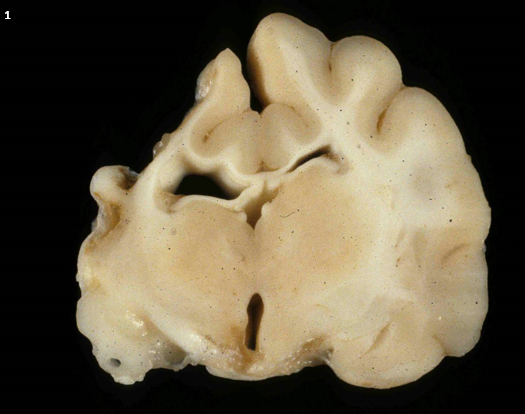
Tissue from a cat. Name the condition:
Feline ischemic encephalopathy
Necrotizing meningoencephalitis
Feline hippocampal necrosis
Traumatic cerebral encephalopathy
Tissue from a cat. Name the condition:
Feline ischemic encephalopathy
Necrotizing meningoencephalitis
Feline hippocampal necrosis
Traumatic cerebral encephalopathy
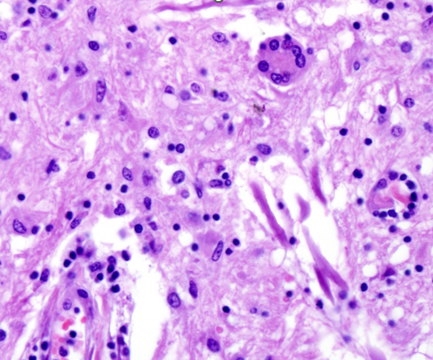
Tissue from a horse. Which of the following is NOT true?
Gross lesions in this condition are confined to the CNS.
The organism does not form a parasitophorous vacuole in infected cells.
Gametogony occurs in the spinal cord and brain in affected horses.
Lesions are primarily seen in the brainstem and cervical and thoracic spinal cord.
Tissue from a horse. Which of the following is NOT true?
Gross lesions in this condition are confined to the CNS.
The organism does not form a parasitophorous vacuole in infected cells.
Gametogony occurs in the spinal cord and brain in affected horses. (gametogeny happens in the definitive host which is an opossum)
Lesions are primarily seen in the brainstem and cervical and thoracic spinal cord.
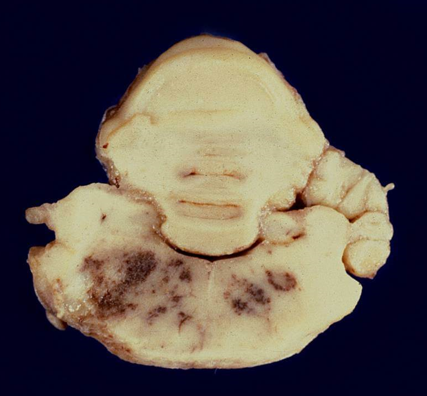
3. Tissue from a sheep. Which of the following is true concerning this agent?
This agent may utilize axonal transport mechanisms to infect the central nervous system.
Lesions associated with sepsis will be seen in various organs, especially the liver in this individual.
This Gram-negative organism is resistant to harsh environmental conditions including low temperatures and low pH.
This viral disease is generally preceded by mild, often inapparent respiratory disease.
3. Tissue from a sheep. Which of the following is true concerning this agent?
This agent may utilize axonal transport mechanisms to infect the central nervous system.
Lesions associated with sepsis will be seen in various organs, especially the liver in this individual.
This Gram-negative organism is resistant to harsh environmental conditions including low temperatures and low pH.
This viral disease is generally preceded by mild, often inapparent respiratory disease.
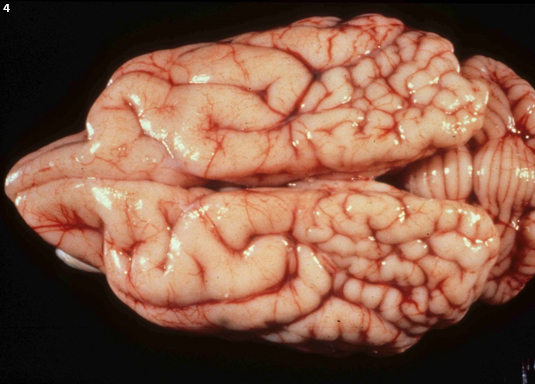
4. Tissue from a dog. Which of the following is correct?
Ulegyria; seen in Pugs
Pachygyria; seen in Bull Mastiffs
Cortical dysplasia; seen in Collies and Shelties
Polymicrogyria; seen in Standard Poodles.
4. Tissue from a dog. Which of the following is correct?
Ulegyria; seen in Pugs
Pachygyria; seen in Bull Mastiffs
Cortical dysplasia; seen in Collies and Shelties
Polymicrogyria; seen in Standard Poodles.
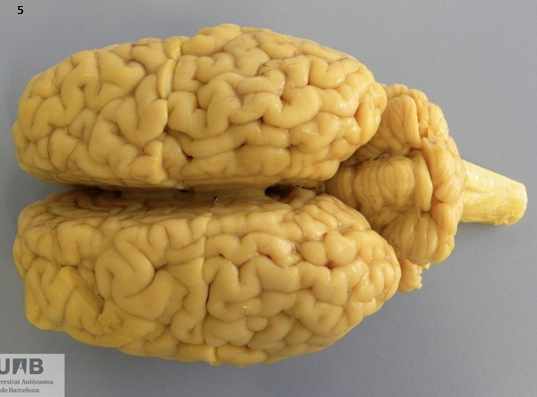
Tissue from a neonatal foal. What is the appropriate pathogenesis?
Hereditary deficiency of uridine diphosphate glucuronyltransferase.
Hereditary abnormality of secretion of conjugated bilirubin.
Portal vein hypoplasia resulting in high levels of unconjugated bilirubin and hyperammonemia.
Neonatal isoeryrthrolysis resulting in high levels of unconjugated bilirubin.
Tissue from a neonatal foal. What is the appropriate pathogenesis?
Hereditary deficiency of uridine diphosphate glucuronyltransferase (UGTs are membrane-bound enzymes that catalyze the conjugation of glucuronic acid onto a diverse set of xenobiotics.)
Hereditary abnormality of secretion of conjugated bilirubin.
Portal vein hypoplasia resulting in high levels of unconjugated bilirubin and hyperammonemia.
Neonatal isoeryrthrolysis resulting in high levels of unconjugated bilirubin.

6. Tissue from a dog. Which of the following gene products has NOT been incriminated in this developmental abnormality?
Doublecortin
Neurulin
LIS-1
Reelin
6. Tissue from a dog. Which of the following gene products has NOT been incriminated in this developmental abnormality?
Doublecortin
Neurulin
LIS-1
Reelin
Lissencephaly; Lhasa apso
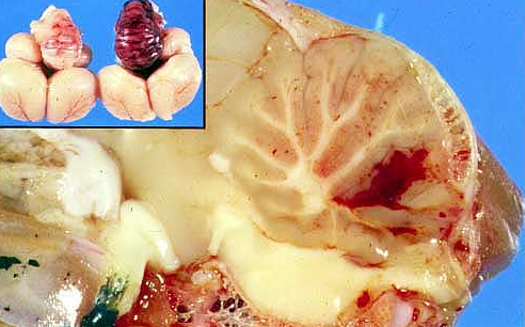
7. Tissue from a turkey. Which of the following is NOT true?
Vitamin E deficiency is the cause of avian encephalomyelitis.
Vitamin E prevents cellular damage by free radicals.
The causative lesion in affected poults is endothelial necrosis of capillaries.
Other lesions associated with Vitamin E deficiency are exudative diasthesis and nutritional myopathy.
7. Tissue from a turkey. Which of the following is NOT true?
Vitamin E deficiency is the cause of avian encephalomyelitis (caused by Tremovirus, a Picornavirus, mostly in chickens)
Vitamin E prevents cellular damage by free radicals.
The causative lesion in affected poults is endothelial necrosis of capillaries.
Other lesions associated with Vitamin E deficiency are exudative diasthesis and nutritional myopathy.

8. Tissue from a dog. This slide represents brain herniation under the ______?
Falx cerebri
Tentorium cerebelli
Sella vermis
Foramen magnum
8. Tissue from a dog. This slide represents brain herniation under the ______?
Falx cerebri
Tentorium cerebelli
Sella vermis
Foramen magnum
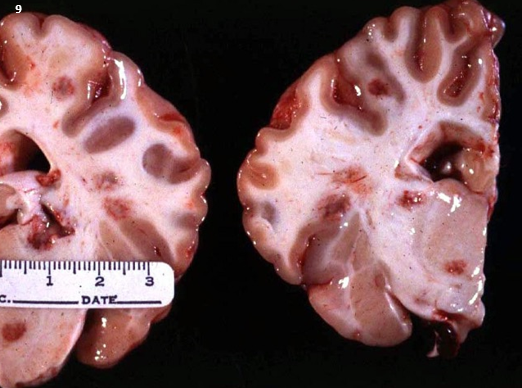
9. Tissue from an ox. Which of the following mechanisms does the agent in the condition above utilize to cause endothelial damage?
Elaboration of lipopolysaccharide
Formation of biofilms
Stimulation of endothelial selectins which result in neutrophil-endothelial adhesion.
Elaboration of perforin
9. Tissue from an ox. Which of the following mechanisms does the agent in the condition above utilize to cause endothelial damage?
Elaboration of lipopolysaccharide
Formation of biofilms (Intravascular H. somni forms large biofilm-like aggregates adherent to the luminal surface of microvascular endothelium.)
Stimulation of endothelial selectins which result in neutrophil-endothelial adhesion. (Helicobacter pylori, E. coli, S. aureus, Listeria, Borrelia burgdorferi)
Elaboration of perforin
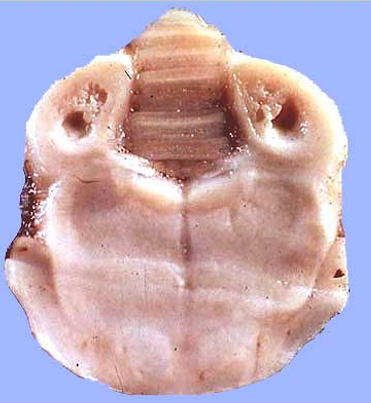
10. Tissue from a dog. Which of the following is true?
Affected ruminants have lesions in the brainstem nuclei rather than the periventricular nuclei.
Affected carnivores have elevated levels of blood pyruvate dehydrogenase.
Lesions are most often seen in the periventricular grey matter.
Phosphorylated thiamine is the coenzyme transketolase, which is involved in oxidative decarboxylase reactions throughout the body.
10. Tissue from a dog. Which of the following is true?
Affected ruminants have lesions in the brainstem nuclei rather than the periventricular nuclei. (ruminants get laminar necrosis)
Affected carnivores have elevated levels of blood pyruvate dehydrogenase. (elevated blood pyruvate)
Lesions are most often seen in the periventricular grey matter. (more specifically, the inferior colliculi and the medial, red, and lateral geniculate nuclei are affected)
Phosphorylated thiamine is the coenzyme transketolase, which is involved in oxidative decarboxylase reactions throughout the body.
Phosphorylated thiamine is the coenzyme cocarboxylase
Cocarboxylase is a cofactor for: Transketolase
Transketolase is utilized in the hexose monophosphate shunt, is active in the white matter, and is important in the metabolism of oligodendrocytes
Decreased transketolase activity > decreased glucose utilization > metabolic burst > production of lactic acid > focal lesions
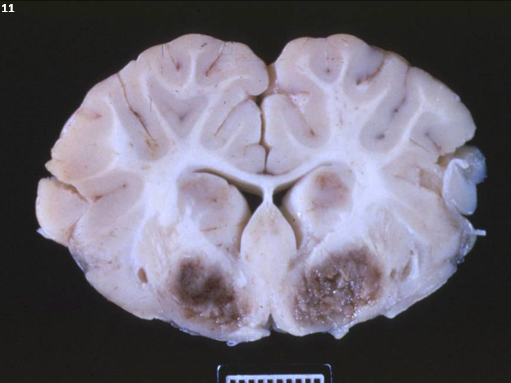
11. Tissue from a sheep. Which of the following is NOT true concerning this condition?
All ages of sheep can be affected except newborns.
The causative agent produces epsilon toxin and iota toxin.
The marked hyperglycemia and hyperglycosuria resulting from infection causes a pulpy aspect to the kidneys.
While all ruminants are susceptible to this disease, only sheep suffer from the neurologic disease.
11. Tissue from a sheep. Which of the following is NOT true concerning this condition?
All ages of sheep can be affected except newborns.
The causative agent produces epsilon toxin and alpha toxin.
The marked hyperglycemia and hyperglycosuria resulting from infection causes a pulpy aspect to the kidneys. (ETX binds receptors on distal renal tubular epithelial cells > renal tubular degeneration and necrosis; however rapid postmortem autolysis may also play a role in “pulpy” kidneys)
While all ruminants are susceptible to this disease, only sheep suffer from the neurologic disease.

12. Tissue from a neonatal lamb. (Normal on left). What is the most likely cause of this lesion?
Copper deficiency (dam)
Hypothyroidism (dam)
Ovine pestivirus (in utero infection)
Veratrum californicum ingestion (dam)
12. Tissue from a neonatal lamb. (Normal on left). What is the most likely cause of this lesion?
Copper deficiency (dam)
Hypothyroidism (dam)
Ovine pestivirus (in utero infection); note the lack of white matter d/t hypomyelinosis
Veratrum californicum ingestion (dam)
Hypomyelinosis is the characteristic neural lesion of Border disease
The cavitating cerebral defects and cerebellar dysplasia arise from inflammatory destruction of developing neural elements, possibly secondary to vasculitis.

13. Tissue from a dog. What is the most appropriate morphologic diagnosis?
Astrocytoma
Gliomatosis cerebri
Ependymoma
Oligodendroglioma
13. Tissue from a dog. What is the most appropriate morphologic diagnosis?
Astrocytoma
Gliomatosis cerebri
Ependymoma
Oligodendroglioma
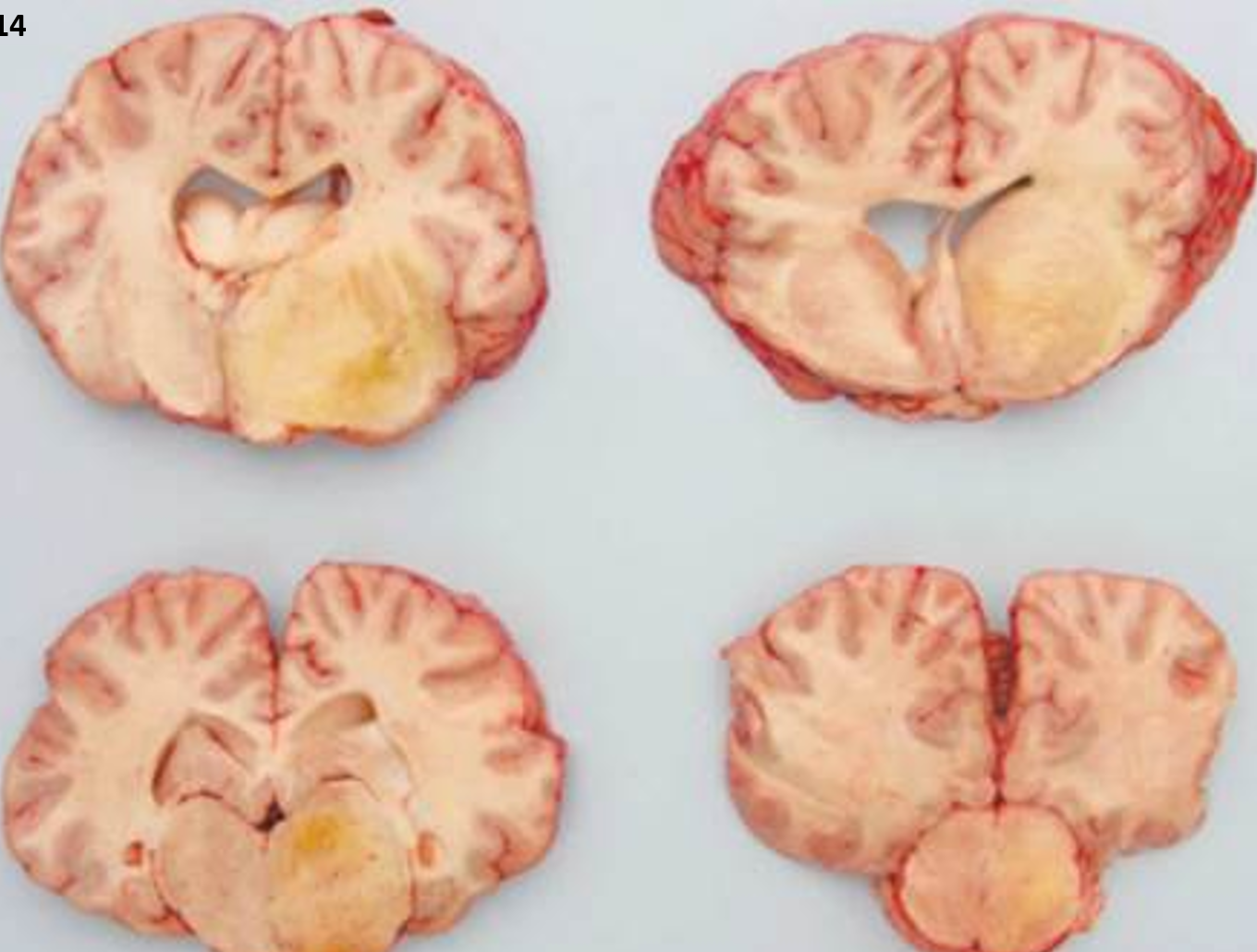
14. Tissue from a horse. The causative agent for this condition is:
Fusarium verticilloides
Trypanosoma evansi
Burkholderia mallei
Equine orbivirus
14. Tissue from a horse. The causative agent for this condition is:
Fusarium verticilloides
Trypanosoma evansi
Burkholderia mallei
Equine orbivirus
Vet Path: Grossly, asymmetric leukoencephalomalacia with yellowish discoloration of white matter and flattening of the gyri were observed in the brain of 7 of 9 horses. Histologically, all 9 horses had necrotizing encephalitis that was most severe in the white matter, with edema, demyelination, and lymphoplasmacytic perivascular cuffs.
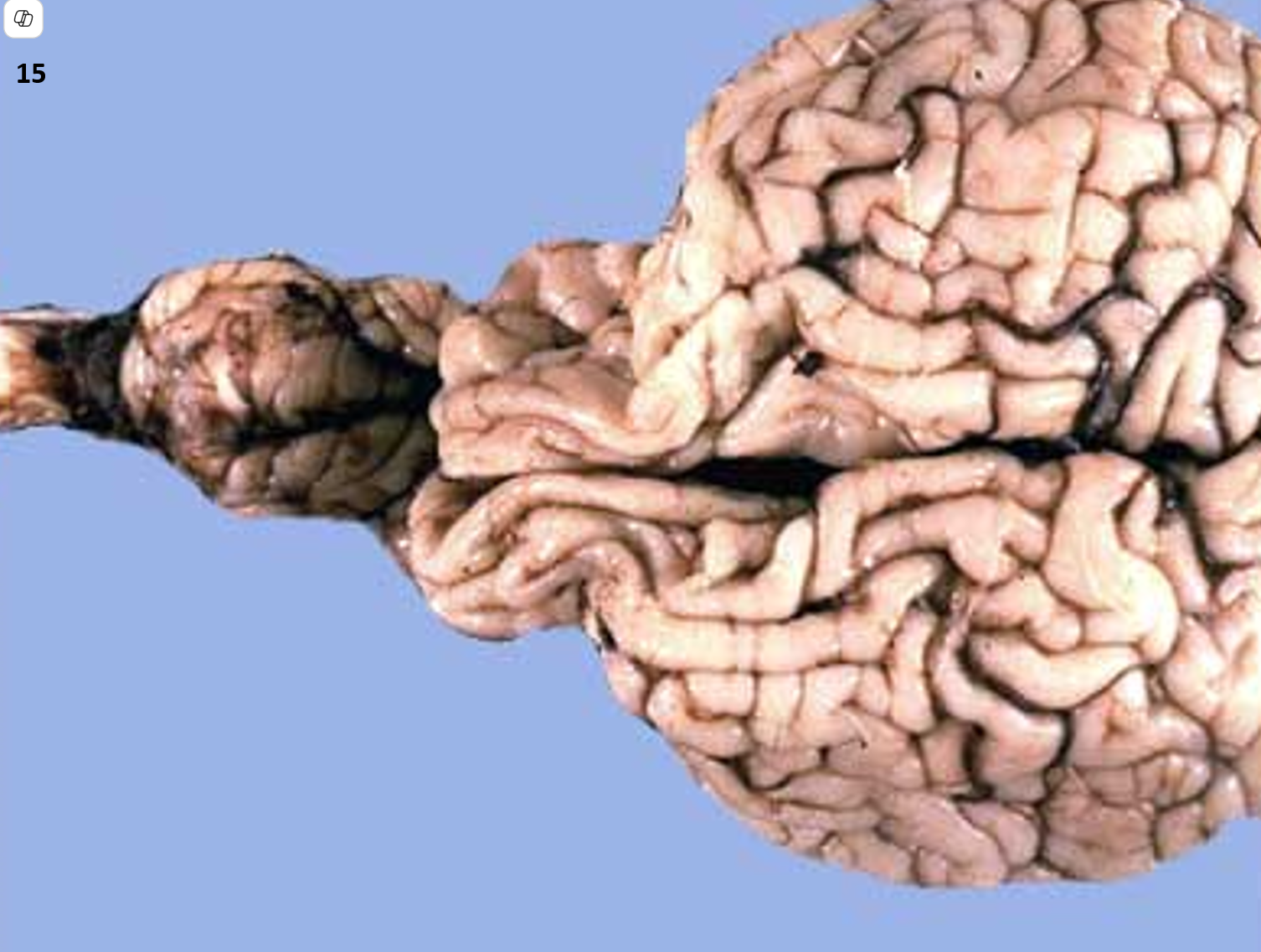
15. Tissue from a calf. Name this condition.
Cerebellar hypoplasia
Dandy-Walker malformation
Arnold-Chiari malformation
Cerebellar abiotrophy
15. Tissue from a calf. Name this condition.
Cerebellar hypoplasia
Dandy-Walker malformation
Arnold-Chiari malformation
Cerebellar abiotrophy
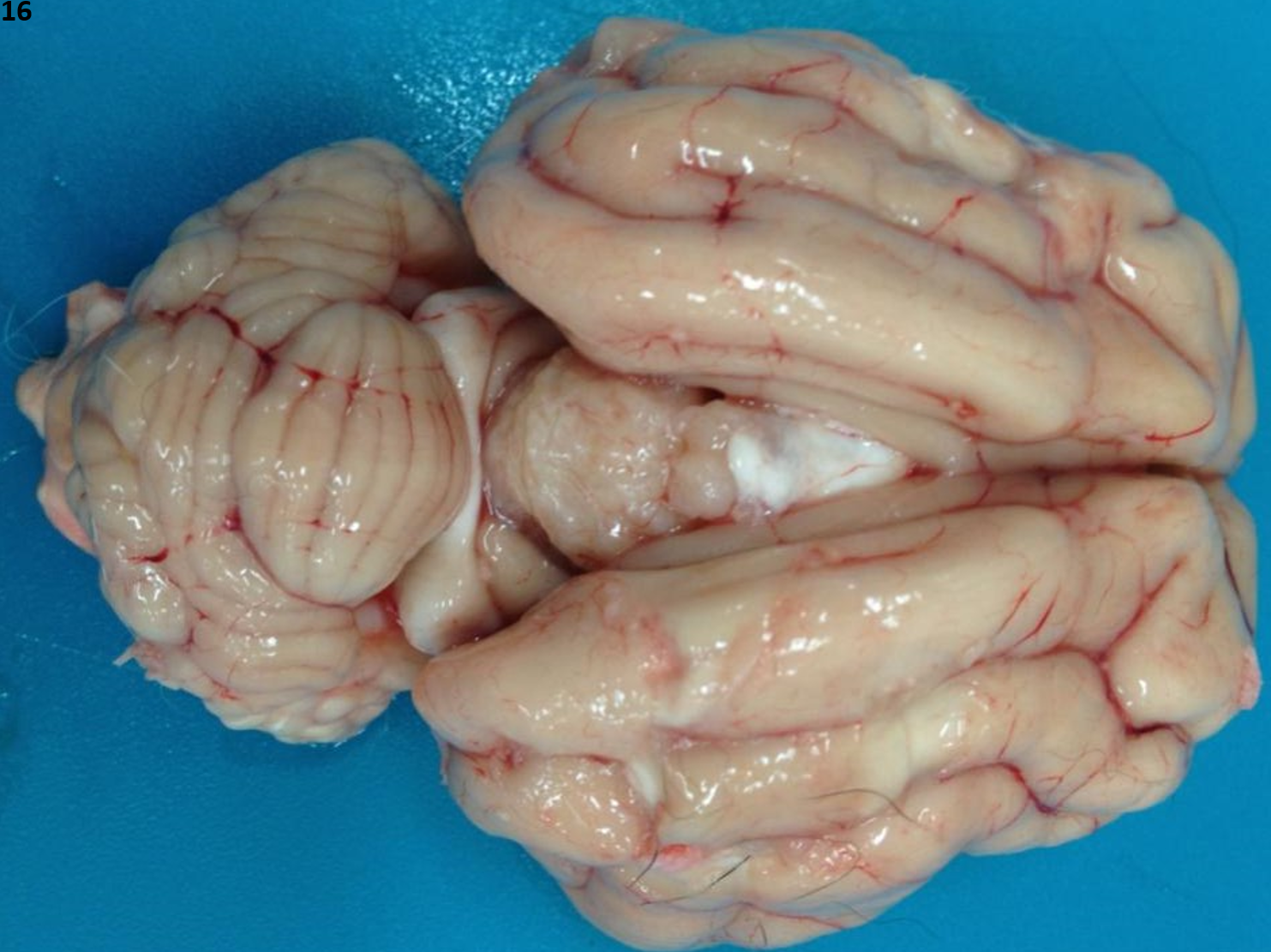
16. Tissue from a cat. What is the most appropriate morphologic diagnosis?
Meningioma
Feline cholesterol granuloma
Choroid plexus papilloma
Mutated feline coronavirus infection
16. Tissue from a cat. What is the most appropriate morphologic diagnosis?
Meningioma
Feline cholesterol granuloma
Choroid plexus papilloma
Mutated feline coronavirus infection
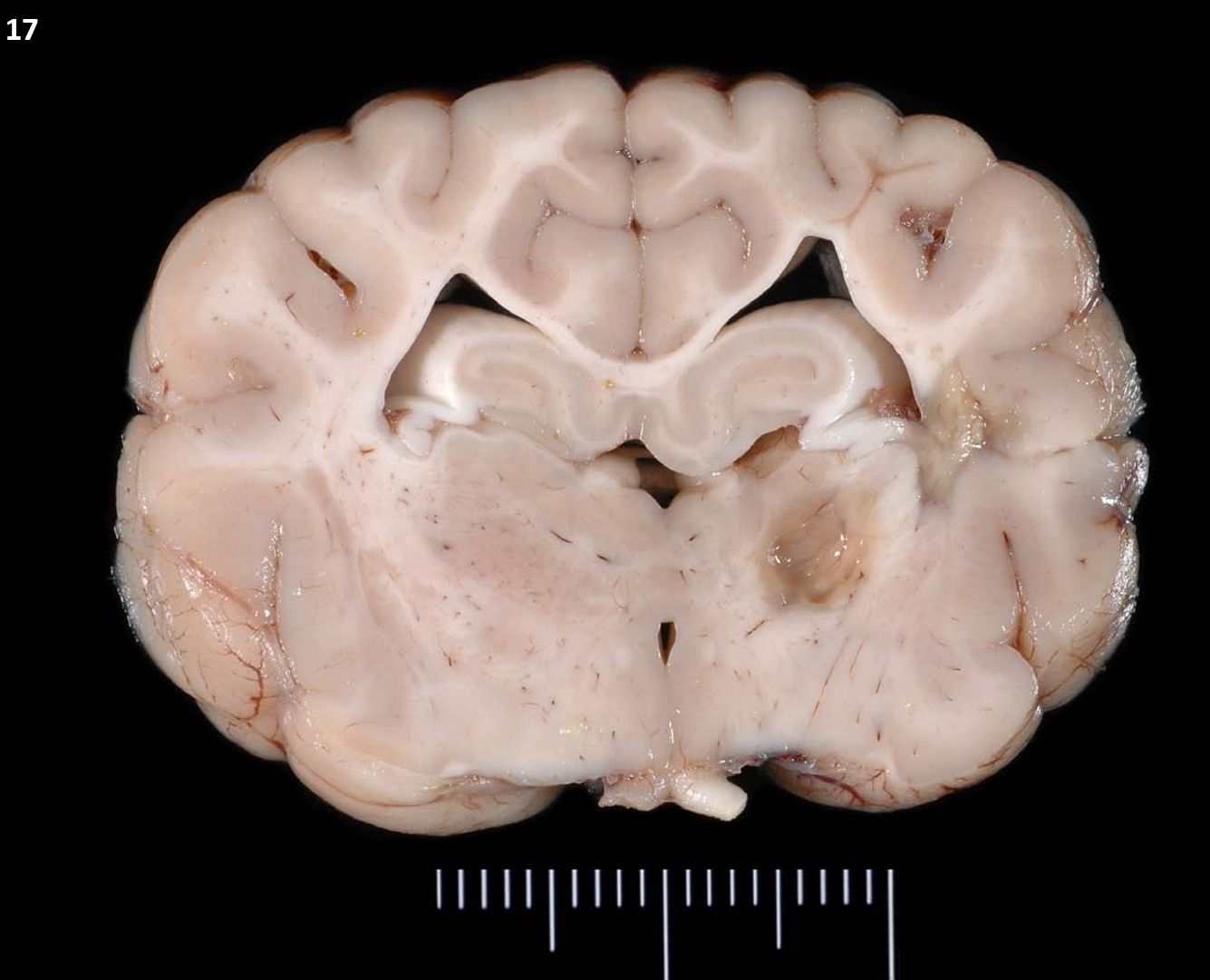
17. Tissue from a dog. The most likely breed of this individual is?
Maltese
Chihuahua
Yorkie
Pug
17. Tissue from a dog. The most likely breed of this individual is?
Maltese
Chihuahua
Yorkie
Pug (Necrotizing meningoencephalitis (NME): would have been grey and white matter; this seems pretty tough on this image and this disease may actually be a continuum)
Necrotizing leukoencephalitis (NLE): Characterized by infiltration by inflammatory cells into the white matter of the cerebrum and brainstem, with consequent widespread cavitation necrosis, demyelination, perivascular lymphoplasmacytic cuffing and glial scarring.
Yorkies are more little (NLE) and pugs are more medium (NME)
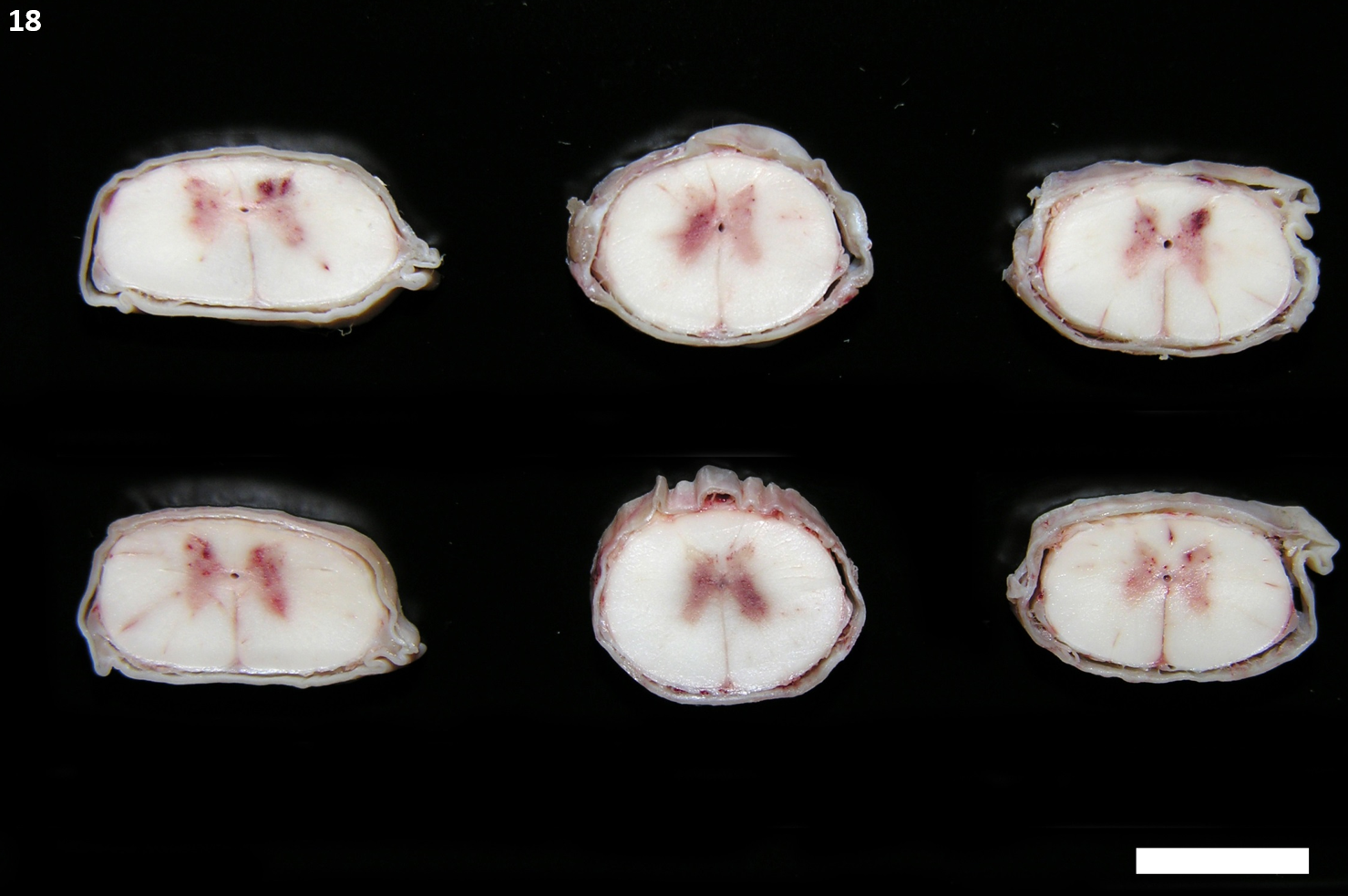
18. Tissue from a horse. Which of the following is NOT a plausible rule-out for this lesion?
Equine herpesvirus-1
Equine rhabdovirus
Post-anesthetic myelopathy
Equine flavivirus
18. Tissue from a horse. Which of the following is NOT a plausible rule-out for this lesion?
Equine herpesvirus-1
Equine rhabdovirus
Post-anesthetic myelopathy (Grossly, there is marked hemorrhage throughout the gray matter of the spinal cord and acute neuronal necrosis)
Equine flavivirus
The virus is endotheliotropic, epitheliotropic, and neurotropic, but not neurovirulent.
thrombo-occlusive necrotizing vasculitis
The characteristic histologic lesions are nonsuppurative necrotizing vasculitis and thrombosis
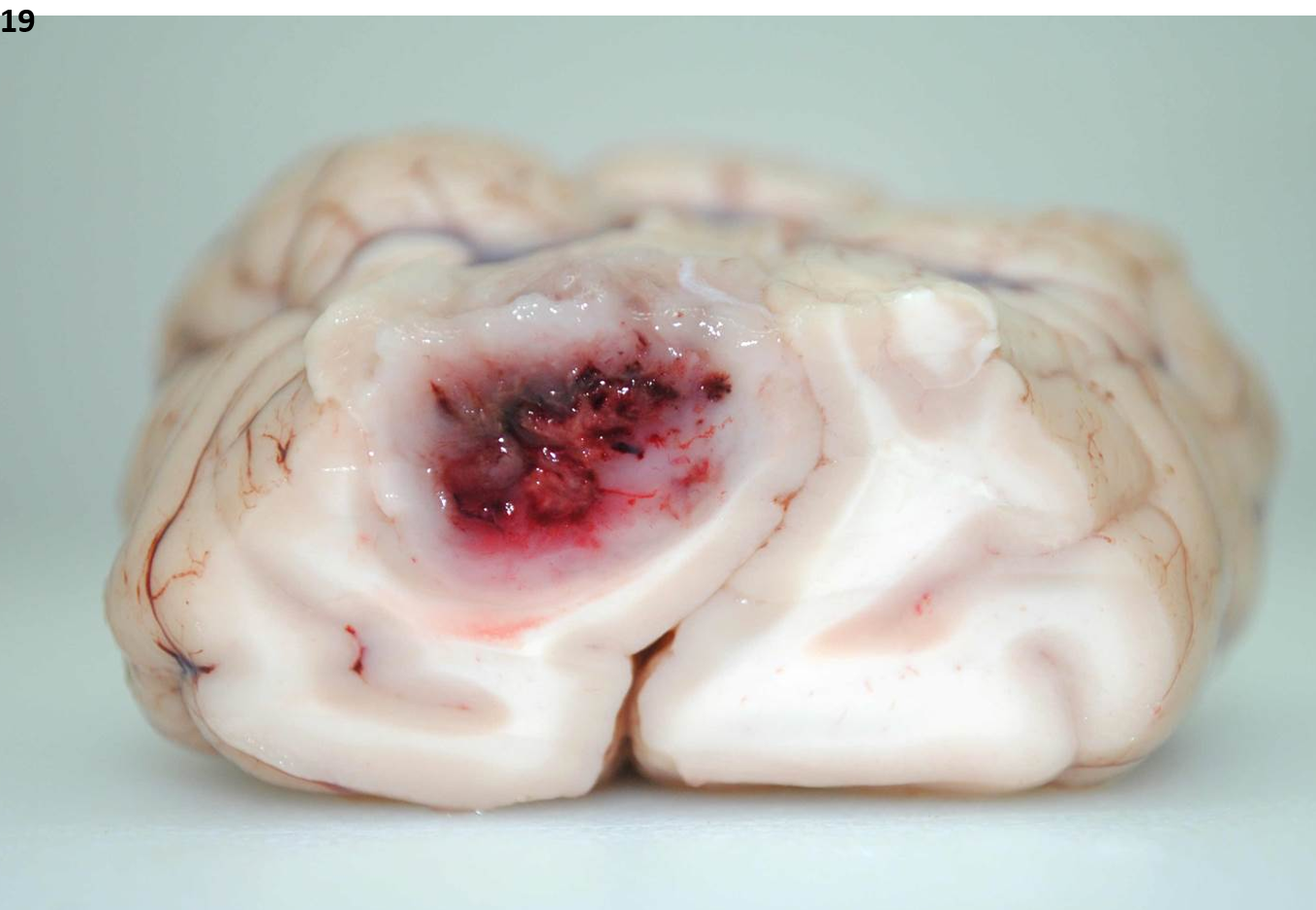
19. Tissue from a dog. Which of the following immunostains is LEAST likely to be positive in this neoplasm?
Doublecortin
Leu-7
GFAP
Olig-1
19. Tissue from a dog. Which of the following immunostains is LEAST likely to be positive in this neoplasm?
Doublecortin
Leu-7
GFAP
Olig-1
Oligodendroglioma: Pink-red to gray, soft, gelatinous, fluctuant, and/or translucent
Occasional multifocal hemorrhage; central area may be cystic in larger tumors
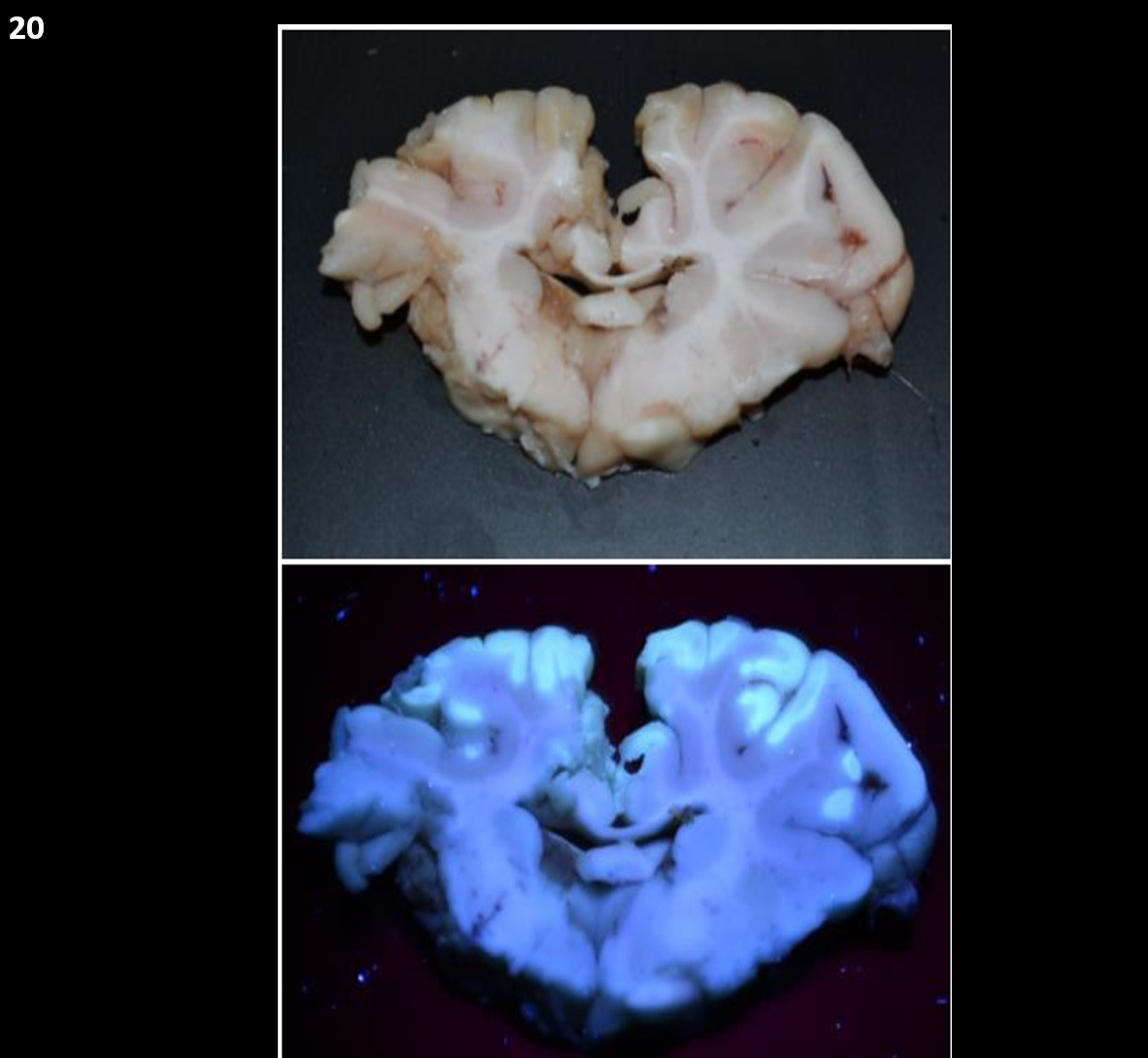
20. Tissue from an ox. Which of the following is NOT a potential cause for this lesion?
Water deprivation
Bracken fern ingestion
Cobalt toxicity
Lead toxicity
20. Tissue from an ox. Which of the following is NOT a potential cause for this lesion?
Water deprivation
Bracken fern ingestion
Cobalt toxicity
Lead toxicity
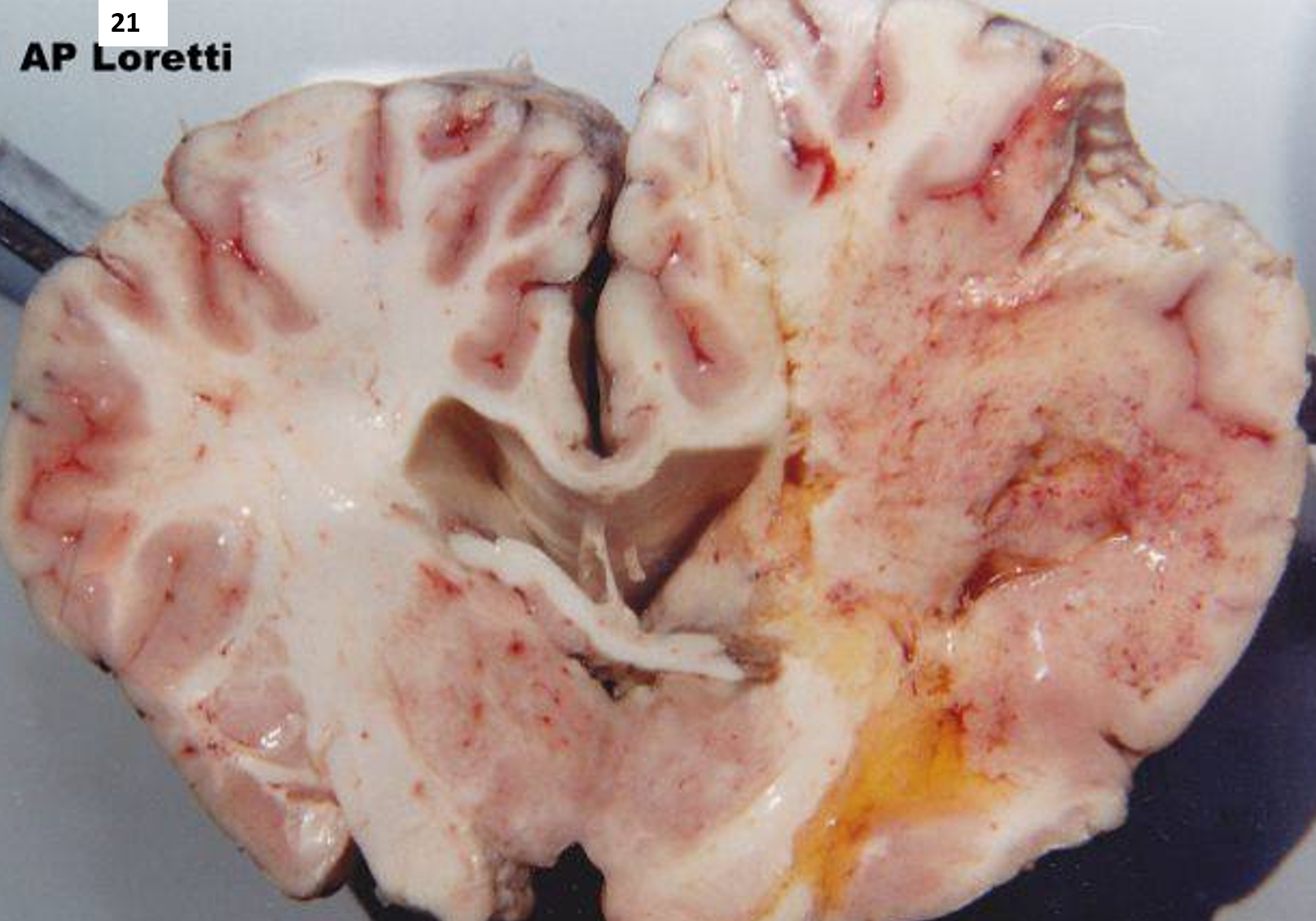
21. Tissue from a horse. Which of the following is NOT true?
Associated lesions in the brainstem and spinal cord are present within the grey matter.
Liver lesions may accompany brain lesions.
Swine affected by this toxin have myocardial necrosis.
Both sphingosine and sphinganine are elevated in affected animals.
21. Tissue from a horse. Which of the following is NOT true?
Associated lesions in the brainstem and spinal cord are present within the grey matter.
Liver lesions may accompany brain lesions.
Swine affected by this toxin have myocardial necrosis (while cardiotoxicity is reported; the main lesion is severe interlobular edema and hydrothorax)
Both sphingosine and sphinganine are elevated in affected animals.
Fumonisin B2; build up of sphinganine and spingosine; lack of sphingolipid = leukomalacia
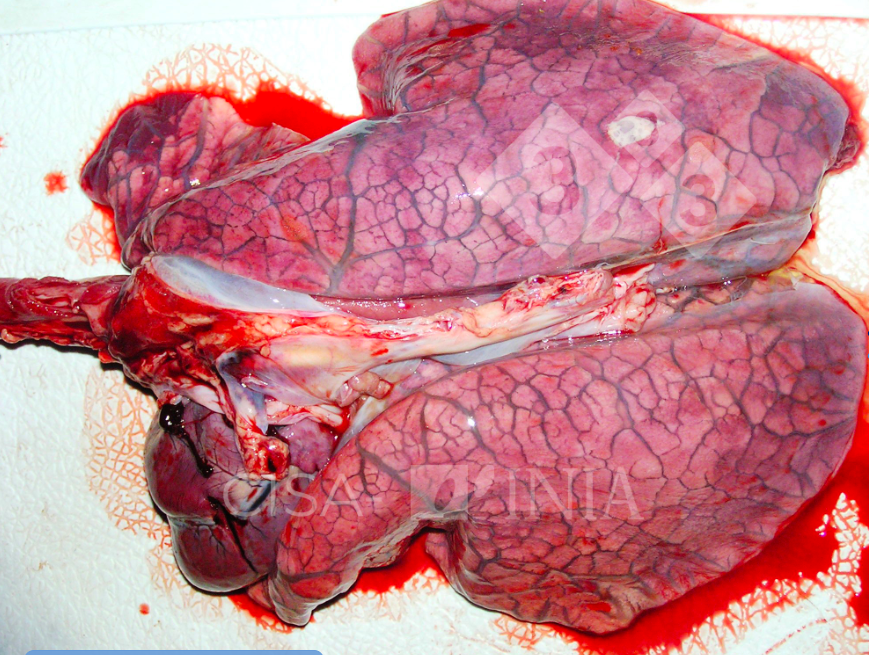
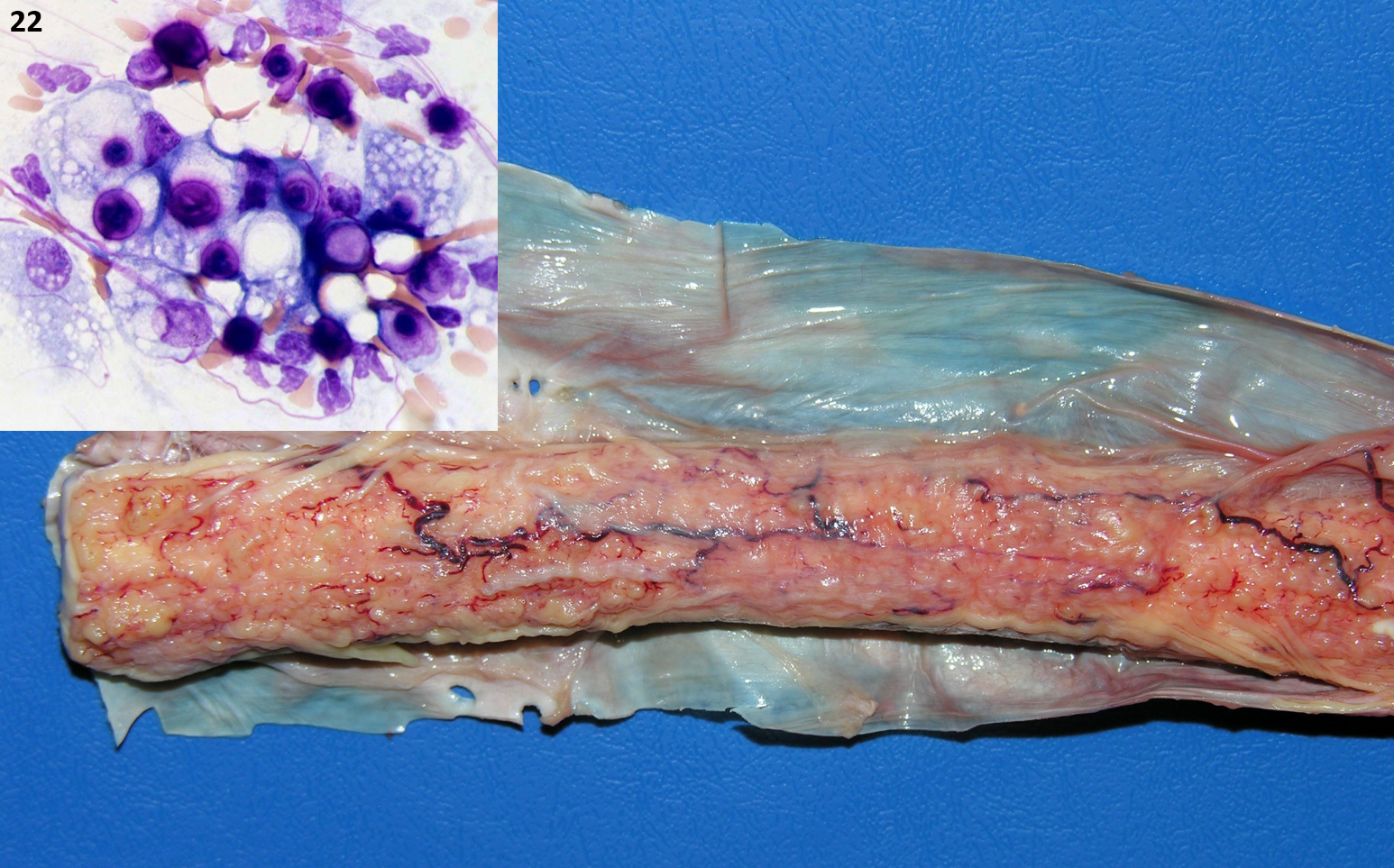
22. Tissue from a cat. Name the most likely agent.
Histoplasma capsulatum
Blastomyces dermatitidis
Coccidioides immitis
Cryptococcus neoformans
22. Tissue from a cat. Name the most likely agent.
Histoplasma capsulatum
Blastomyces dermatitidis
Coccidioides immitis
Cryptococcus neoformans
Remember: C. gattii is a primary pathogen than can cause disease in immunocompetent hosts
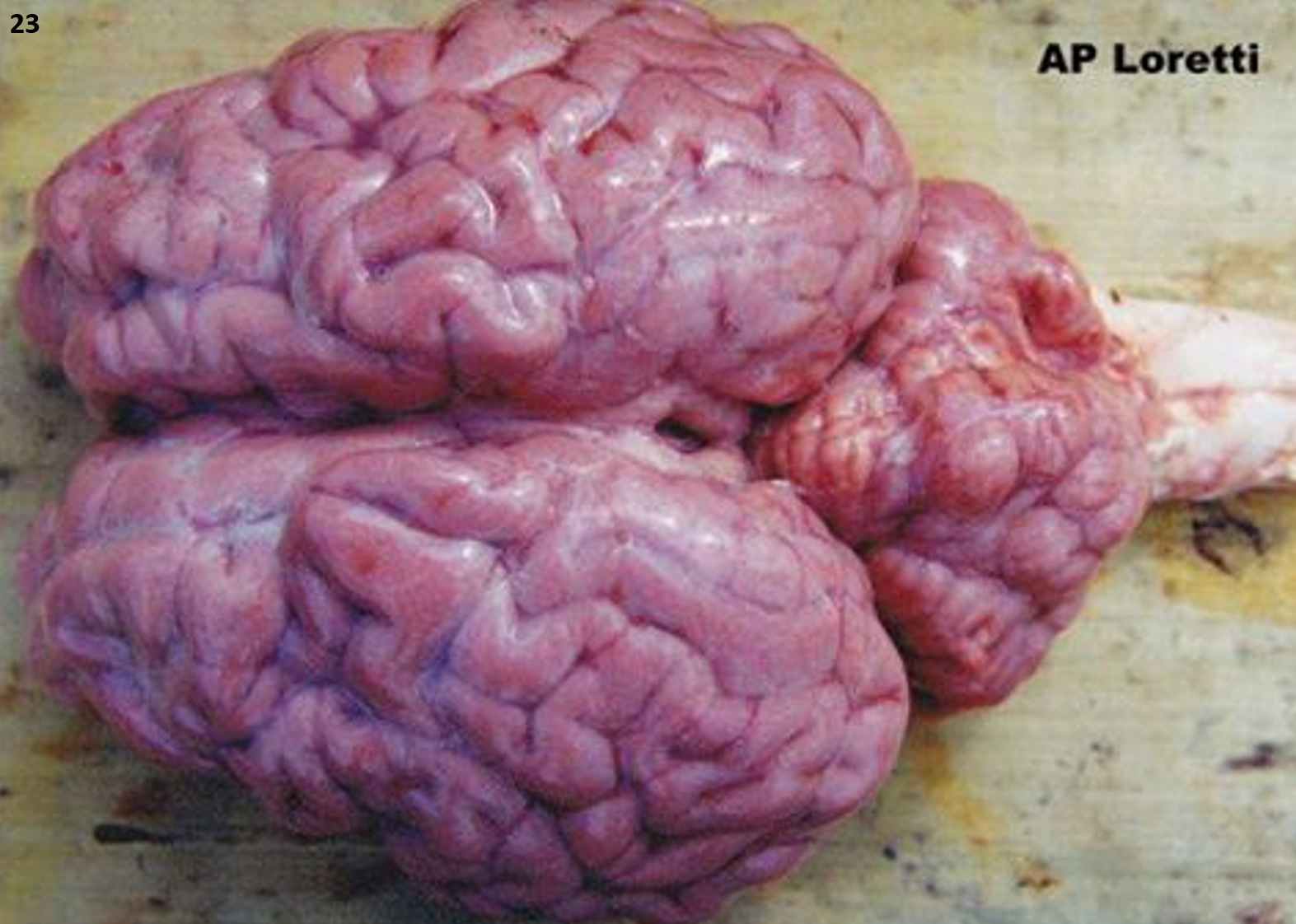
23. Tissue from a calf. Which of the following is NOT true?
The cerebral flush seen here is seen only with Babesia bovis and no other species of Babesia.
Hemolytic anemia is not a feature of this condition.
The flush is the result of marked dilation and congestion of cerebral vessels with parasitized erythrocytes.
Splenomegaly is almost always seen in this condition.
23. Tissue from a calf. Which of the following is NOT true?
The cerebral flush seen here is seen only with Babesia bovis and no other species of Babesia.
Hemolytic anemia is not a feature of this condition; it is
The flush is the result of marked dilation and congestion of cerebral vessels with parasitized erythrocytes.
Splenomegaly is almost always seen in this condition.

24. Tissue from a dog. The most appropriate gross diagnosis in this case would be an interventricular _________:
Astrocytoma
Oligodendroglioma
Ependymoma
Meningioma
24. Tissue from a dog. The most appropriate gross diagnosis in this case would be an interventricular _________:
Astrocytoma
Oligodendroglioma
Ependymoma
Meningioma
This is based on an old JVDI article; I think the most likely would still be ependymoma?
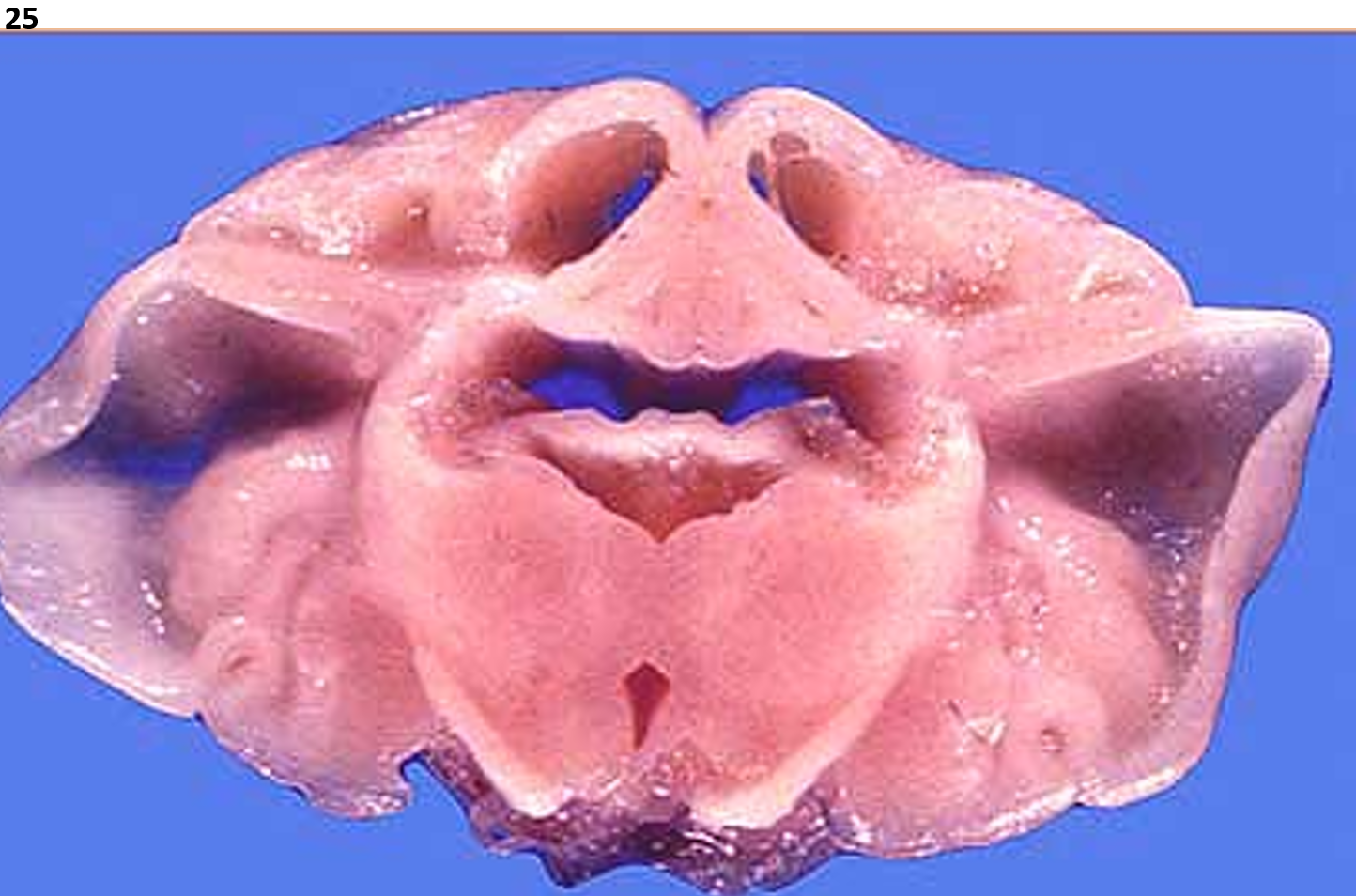
25. Tissue from a neonatal lamb. What is the most likely cause?
a. Ovine pestivirus (in utero infection)
b. Ovine bunyavirus (in utero infection)
c. Copper deficiency (dam)
d. Hypothyroidism (dam)
25. Tissue from a neonatal lamb. What is the most likely cause?
a. Ovine pestivirus (in utero infection)
b. Ovine bunyavirus (in utero infection)
c. Copper deficiency (dam)
d. Hypothyroidism (dam)
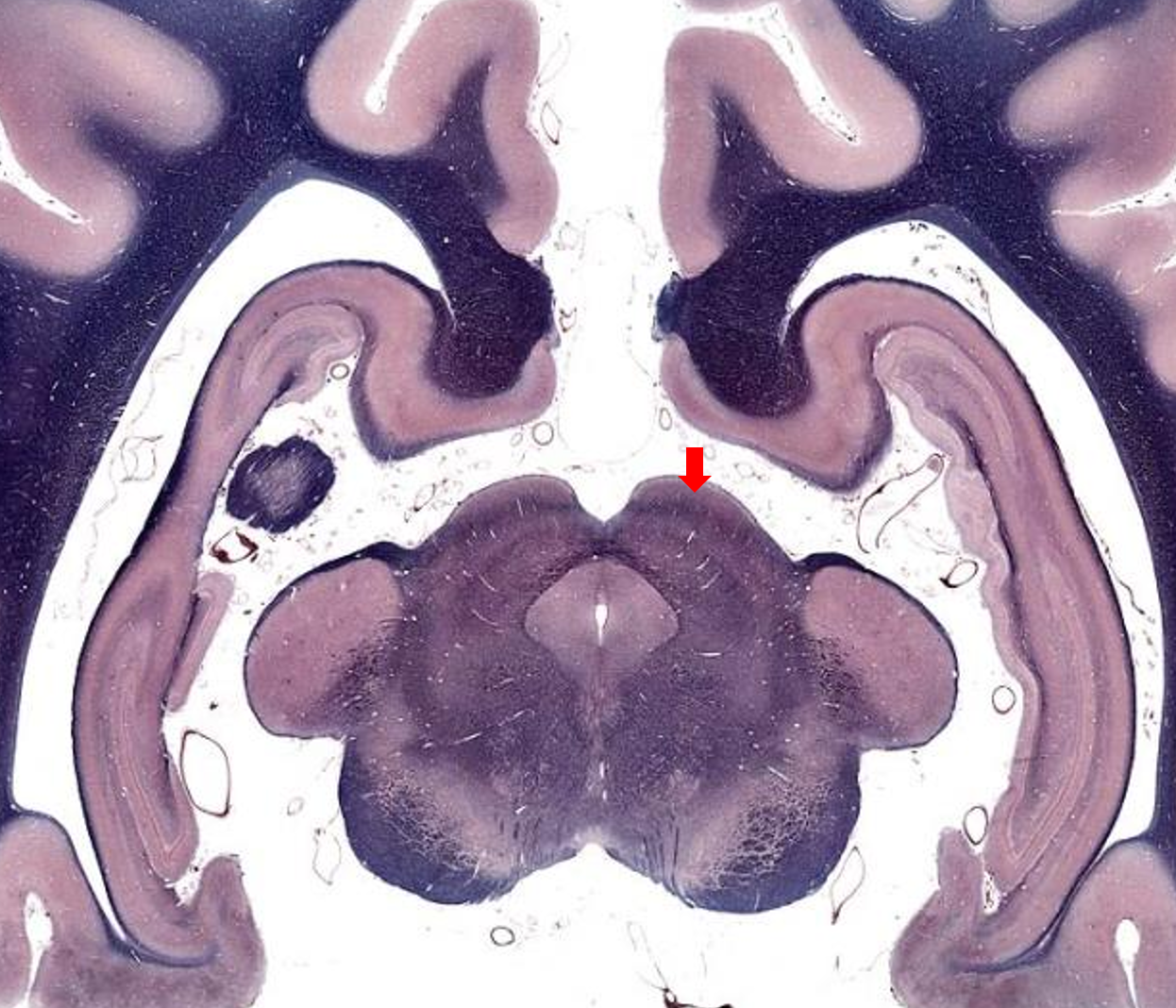
26. Name the part of the canine brain indicated by the arrow.
a. Substantia nigra
b. Thalamus
c. Pyramidal tract
d. Rostral colliculus
26. Name the part of the canine brain indicated by the arrow.
a. Substantia nigra
b. Thalamus
c. Pyramidal tract
d. Rostral colliculus
27. Which of the following histochemical techniques stains degenerating neurons?
a. Cresyl violet
b. Luxol fast blue
c. Calretinin
d. Phosphotungstic acid hematoxylin
e. Amino cupric silver technique
27. Which of the following histochemical techniques stains degenerating neurons?
a. Cresyl violet
b. Luxol fast blue
c. Calretinin
d. Phosphotungstic acid hematoxylin
e. Amino cupric silver technique (also fluoro-Jade)
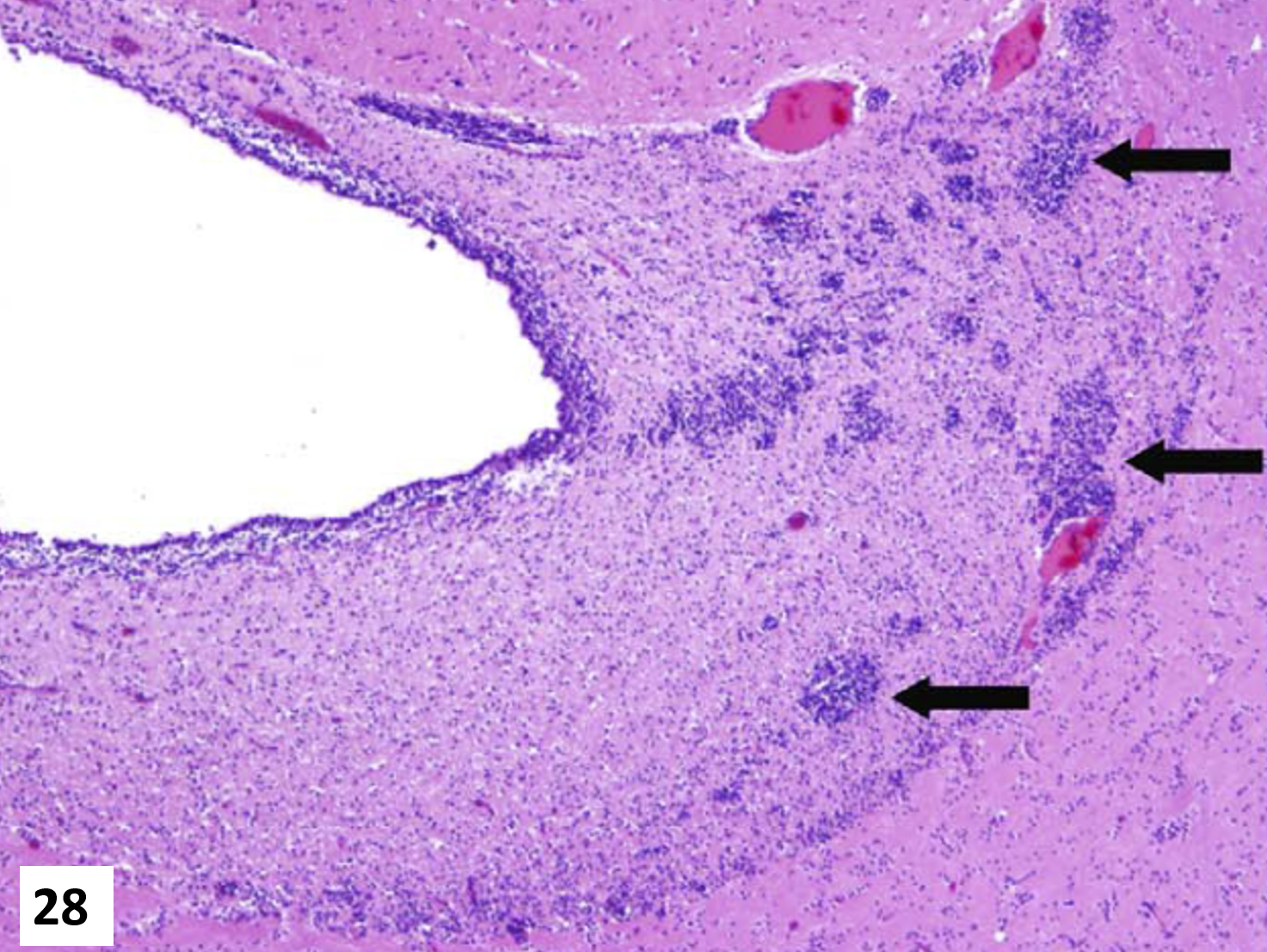
28. Tissue from a cat. What are the arrows pointing to?
a. Germinal cells arranged in islands of Calleja
b. Migrating precursor cells of the external granular layer of the developing cerebellum
c. The blastemal component of a neuroblastoma
d. Subventricular and perivascular mononuclear inflammation
e. Microgliosis
28. Tissue from a cat. What are the arrows pointing to?
a. Germinal cells arranged in islands of Calleja
b. Migrating precursor cells of the external granular layer of the developing cerebellum
c. The blastemal component of a neuroblastoma
d. Subventricular and perivascular mononuclear inflammation
e. Microgliosis
29. Which 2 neural structures are the most sensitive to ischemic injury?
a. Neurons and astrocytes
b. Neurons and oligodendroglia
c. Neurons and microglia
d. Astrocytes and oligodendroglia
e. Astrocytes and microglia
29. Which 2 neural structures are the most sensitive to ischemic injury?
a. Neurons and astrocytes
b. Neurons and oligodendroglia
c. Neurons and microglia
d. Astrocytes and oligodendroglia
e. Astrocytes and microglia
neurons > oligodendrocytes > astrocytes > microglia > blood vessels
30. Clostridium piliforme infection can cause ileitis, typhlitis, hepatitis, myocarditis, and encephalitis in which laboratory animal?
a. Rat
b. Mouse
c. Syrian hamster
d. Mongolian gerbil
e. Watanabe rabbit
30. Clostridium piliforme infection can cause ileitis, typhlitis, hepatitis, myocarditis, and encephalitis in which laboratory animal?
a. Rat
b. Mouse
c. Syrian hamster
d. Mongolian gerbil
e. Watanabe rabbit
31. The hallmark histopathological feature of SIVE (Simian Immunodeficiency Virus Encephalitis) in SIV infected NHPs is:
a. Perivascular histiocytic and lymphocytic infiltrates in the cerebrum
b. Multinucleated giant cells in foci of inflammation
c. Glial cell activation
d. Myelin vacuolar degeneration
e. None of the above
31. The hallmark histopathological feature of SIVE (Simian Immunodeficiency Virus Encephalitis) in SIV infected NHPs is:
a. Perivascular histiocytic and lymphocytic infiltrates in the cerebrum
b. Multinucleated giant cells in foci of inflammation
c. Glial cell activation
d. Myelin vacuolar degeneration
e. None of the above
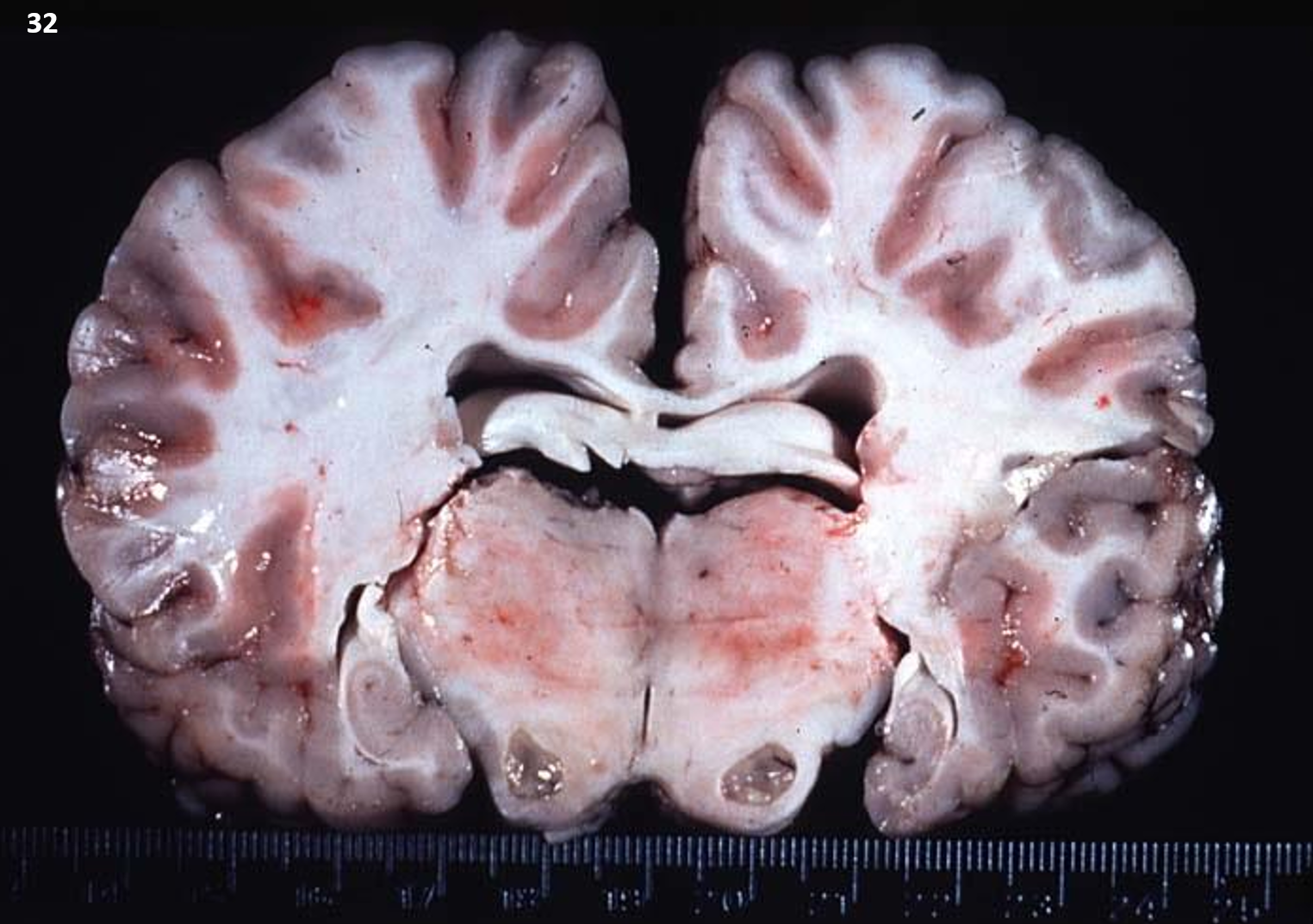
32. Tissue from a horse. What is the cause?
a. Fumonisin B1
b. Ergotamine
c. Repin
d. Lolitrem B
32. Tissue from a horse. What is the cause?
a. Fumonisin B1
b. Ergotamine
c. Repin
d. Lolitrem B
33. What is the most likely cause in 2-week old chick with neuronal central chromatolysis and lymphocytic proventriculitis?
a. Avian tremorvirus
b. Avian bornavirus
c. Vitamin E deficiency
d. α-1, 4-Glucosidase (acid maltase) deficiency
33. What is the most likely cause in 2-week old chick with neuronal central chromatolysis and lymphocytic proventriculitis?
a. Avian tremorvirus
b. Avian bornavirus (parrots; PDD)
c. Vitamin E deficiency (bing cherry cerebellum)
d. α-1, 4-Glucosidase (acid maltase) deficiency (lysosomal storage disease)
34. Alexander disease (fibrinoid leukodystrophy) in dogs is characterized by?
a. Diffuse hypomyelination of the CNS
b. Perivascular white matter accumulation of swollen, foamy, PAS+ macrophages
c. Astrocytic accumulation of GFAP, ubiquitin and heat shock proteins
d. Spongiosis in the spinal cord ventral funiculi
34. Alexander disease (fibrinoid leukodystrophy) in dogs is characterized by?
a. Diffuse hypomyelination of the CNS
b. Perivascular white matter accumulation of swollen, foamy, PAS+ macrophages
c. Astrocytic accumulation of GFAP, ubiquitin and heat shock proteins
d. Spongiosis in the spinal cord ventral funiculi
35. Equine “shivers” is due to ____?
a. End-terminal neuroaxonal degeneration in the deep cerebellar nuclei
b. Neuronal necrosis and neuron phagia in the hippocampus
c. Mutated end-terminal acetylcholine receptors
d. Non-functional calcium-channels within skeletal myocytes
35. Equine “shivers” is due to ____?
a. End-terminal neuroaxonal degeneration in the deep cerebellar nuclei; cerebellum = trouble with coordination; these animals have trouble backing up and tremble when asked to do so
b. Neuronal necrosis and neuron phagia in the hippocampus
c. Mutated end-terminal acetylcholine receptors
d. Non-functional calcium-channels within skeletal myocytes
36. Which is the most characteristic finding associated with transmissible mink encephalopathy?
a. Neuronal vacuolation
b. Spongiosis and astrocytosis
c. Amyloid plaques
d. PrPsc in both the CNS and lymphoid tissue
36. Which is the most characteristic finding associated with transmissible mink encephalopathy?
a. Neuronal vacuolation (seen more in scrapie)
b. Spongiosis and astrocytosis
c. Amyloid plaques
d. PrPsc in both the CNS and lymphoid tissue
37. PCV-2 (porcine circovirus type 2) has been associated with:
a. Vascular fibrinoid necrosis in the choroid plexus
b. Demyelination within the ventral white matter of the spinal cord
c. Bilaterally symmetrical encephalomalacia
d. Syringomyelia
37. PCV-2 (porcine circovirus type 2) has been associated with:
a. Vascular fibrinoid necrosis in the choroid plexus
b. Demyelination within the ventral white matter of the spinal cord
c. Bilaterally symmetrical encephalomalacia
d. Syringomyelia

38. Tissue from a Hereford calf. What is the most likely cause?
a. Deficiency of β-Galactosidase
b. Deficiency of mitochondrial branched-chain a-ketoacid dehydrogenase
c. Bovine prions
d. Trachyandra divaricata ingestion
38. Tissue from a Hereford calf. What is the most likely cause?
a. Deficiency of β-Galactosidase
b. Deficiency of mitochondrial branched-chain a-ketoacid dehydrogenase
c. Bovine prions
d. Trachyandra divaricata ingestion; severe paretic syndrome accompanied by intense neuronal lipofuscinosis in horse and sheep
39. Which of the following best describes the pathogenesis of domoic acid neuronal necrosis in rats?
a. Inhibits ceramide synthase and sphingolipid biosynthesis resulting in neuronal accumulation of toxic sphinganine
b. Binds and inhibits GABA receptors of the internuncial neurons
c. Caused by calcium influx following interaction of domoic acid with AMPA and glutamate receptors
d. There is reduced activity of ATP-dependent sodium and water transport mechanisms leading to intraneuronal swelling
e. Domoic acid causes causes glutathione depletion, increased reactive oxygen species, and cell membrane damage
39. Which of the following best describes the pathogenesis of domoic acid neuronal necrosis in rats?
a. Inhibits ceramide synthase and sphingolipid biosynthesis resulting in neuronal accumulation of toxic sphinganine; fumonisin B2
b. Binds and inhibits GABA receptors of the internuncial neurons; tetanus toxin
c. Caused by calcium influx following interaction of domoic acid with AMPA and glutamate receptors
d. There is reduced activity of ATP-dependent sodium and water transport mechanisms leading to intraneuronal swelling; ischemia?
e. Domoic acid causes causes glutathione depletion, increased reactive oxygen species, and cell membrane damage
40. “Stargazing” in young captive African lions has been associated with:
a. Thickened tentorium cerebelli with cerebellar herniation
b. Leukoencephalomalacia
c. Congenital syringomyelia
d. Lead toxicity
40. “Stargazing” in young captive African lions has been associated with:
a. Thickened tentorium cerebelli with cerebellar herniation
b. Leukoencephalomalacia
c. Congenital syringomyelia
d. Lead toxicity
Stargazing in lions is not a single disease but rather a symptom of various conditions. One common cause is hypovitaminosis A, a deficiency in vitamin A, which can lead to thickening of the skull bones and subsequent pressure on the brain.
41. Which of the following species is often used in stroke research due to their incomplete circle of Willis and susceptibility to cerebral ischemia?
a. Hamster
b. Gerbil
c. Guinea Pig
d. FVB mouse
41. Which of the following species is often used in stroke research due to their incomplete circle of Willis and susceptibility to cerebral ischemia?
a. Hamster
b. Gerbil
c. Guinea Pig
d. FVB mouse
42. A newborn lamb with hydranencaphly, arthrogryposis and loss of spinal ventral motor neurons was likely exposed to which of the following in utero?
a. Border disease virus
b. Bovine viral diarrhea virus
c. Akabane virus
d. Schmallenberg virus
42. A newborn lamb with hydranencaphly, arthrogryposis and loss of spinal ventral motor neurons was likely exposed to which of the following in utero?
a. Border disease virus
b. Bovine viral diarrhea virus
c. Akabane virus; bad question because this is a good option too
d. Schmallenberg virus
43. According to a recent study, in horses with equine degenerative myelopathy neuronal cell bodies of degenerate axons are found in the:
a. Fasciculus cuneatus
b. Fasciculus gracilis
c. Nucleus cuneatus medialis
d. Dorsal root ganglion
43. According to a recent study, in horses with equine degenerative myelopathy neuronal cell bodies of degenerate axons are found in the:
a. Fasciculus cuneatus
b. Fasciculus gracilis
c. Nucleus cuneatus medialis
d. Dorsal root ganglion
44. Tissue from a dog. What is the most likely cause?
a. α/ β –Mannosidase deficiency
b. β-Hexosaminidase deficiency
c. Galactosylceramidase deficiency
d. Palmitoyl protein thioesterase deficiency
44. Tissue from a dog. What is the most likely cause?
a. α/ β –Mannosidase deficiency
b. β-Hexosaminidase deficiency
c. Galactosylceramidase deficiency
d. Palmitoyl protein thioesterase deficiency
'
45. Annual ryegrass staggers is associated with all of the following EXCEPT:
a. Lolium rigidium
b. Yellow slime containing corynetoxin
c. Anguina agrostis
d. Rathayibacter toxicus
e. Neotyphodium lolii
45. Annual ryegrass staggers is associated with all of the following EXCEPT:
a. Lolium rigidium
b. Yellow slime containing corynetoxin
c. Anguina agrostis
d. Rathayibacter toxicus
e. Neotyphodium lolii
Perennial: Lolium perenne (the plant) infested by Neotyphodium lolii (an endophytic fungus) that produces indolic lolitrems (tremorgens; four tremorgenic neurotoxins have been identified: Lolitrem A, B, C, & D (lolitrem B is the most common)
Annual: Annual ryegrass (Lolium rigidium) is parasitized by the nematode Anguina agrostis which carries the bacterium Rathayibacter toxicus and forms a yellow slime that contains a corynetoxin
46. Degenerative myelopathy (DM) in Welsh corgis has been associated with BOTH:
a. LC3 mutation & amyloid deposition
b. SOD1 mutation & dysfunction of autophagy
c. LC3 mutation & cerebellar Purkinje cell degeneration and loss
d. SOD1 mutation & glutamic neuroexcitatory toxicity
46. Degenerative myelopathy (DM) in Welsh corgis has been associated with BOTH:
a. LC3 mutation & amyloid deposition
b. SOD1 mutation & dysfunction of autophagy
c. LC3 mutation & cerebellar Purkinje cell degeneration and loss
d. SOD1 mutation & glutamic neuroexcitatory toxicity
47. Which of the following fish species is most likely to develop neurofibroma/schwannoma?
a. Goldfish
b. Walleye
c. Trout
d. Angelfish
47. Which of the following fish species is most likely to develop neurofibroma/schwannoma?
a. Goldfish
b. Walleye
c. Trout
d. Angelfish
Trachyandra divaricata toxicity in ruminants is associated with:
a. Lipofuscin storage in central and peripheral neurons
b. Brainstem/spinal cord neuroaxonal degeneration with cerebral atrophy/cavitation
c. Ectopic cerebellar purkinje cells and "torpedoes" within a thin cerebellar granular layer
d. Bilaterally symmetrical cerebral gray matter laminar cortical necrosis
Trachyandra divaricata toxicity in ruminants is associated with:
a. Lipofuscin storage in central and peripheral neurons
b. Brainstem/spinal cord neuroaxonal degeneration with cerebral atrophy/cavitation
c. Ectopic cerebellar purkinje cells and "torpedoes" within a thin cerebellar granular layer
d. Bilaterally symmetrical cerebral gray matter laminar cortical necrosis
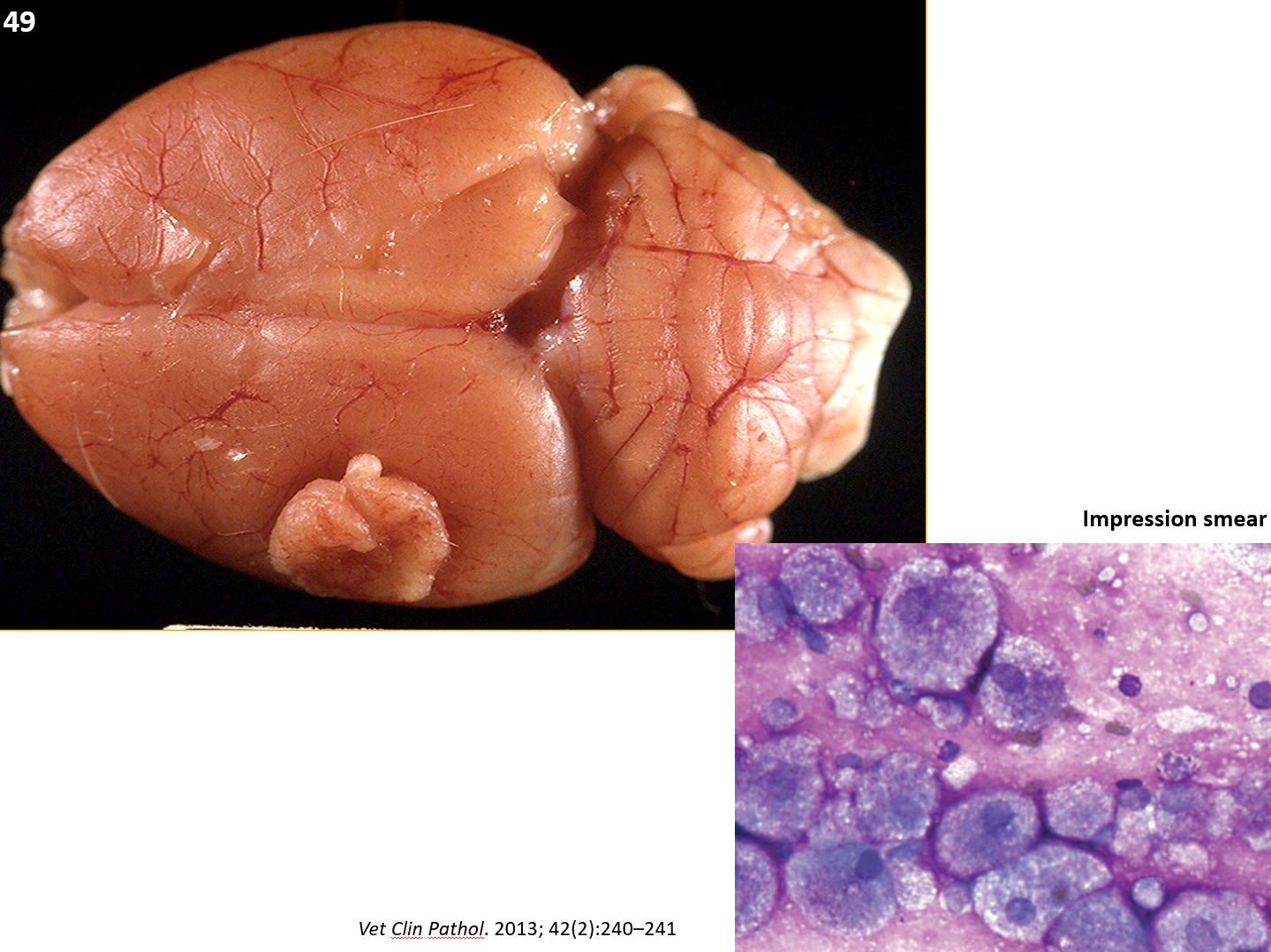
49. Tissue from a Wistar rat. The cytoplasmic “granules” noted in the impression smear have been identified as:
a. Mitochondria
b. Glycogen
c. Lysosomes
d. Rough ER
49. Tissue from a Wistar rat. The cytoplasmic “granules” noted in the impression smear have been identified as:
a. Mitochondria
b. Glycogen
c. Lysosomes
d. Rough ER
This is a granular cell tumor which is a variant of the meningioma in the rat
50. Cheetahs are predisposed to:
a. Hydrocephalus
b. Arnold-Chiari malformation
c. Leukoencephalopathy
d. Degenerative myelopathy
50. Cheetahs are predisposed to:
a. Hydrocephalus
b. Arnold-Chiari malformation
c. Leukoencephalopathy; this is a weird thing of captive cheetahs with an unknown cause; may be genetic
d. Degenerative myelopathy
51. All of the following are typical of Histophilus somni infection in cattle, EXCEPT:
a. Pneumonia
b. Hemorrhagic and necrosuppurative encephalitis
c. Laryngeal ulceration
d. Retinal hemorrhages
e. All of the above lesions are observed with H. somni
51. All of the following are typical of Histophilus somni infection in cattle, EXCEPT:
a. Pneumonia
b. Hemorrhagic and necrosuppurative encephalitis
c. Laryngeal ulceration
d. Retinal hemorrhages
e. All of the above lesions are observed with H. somni
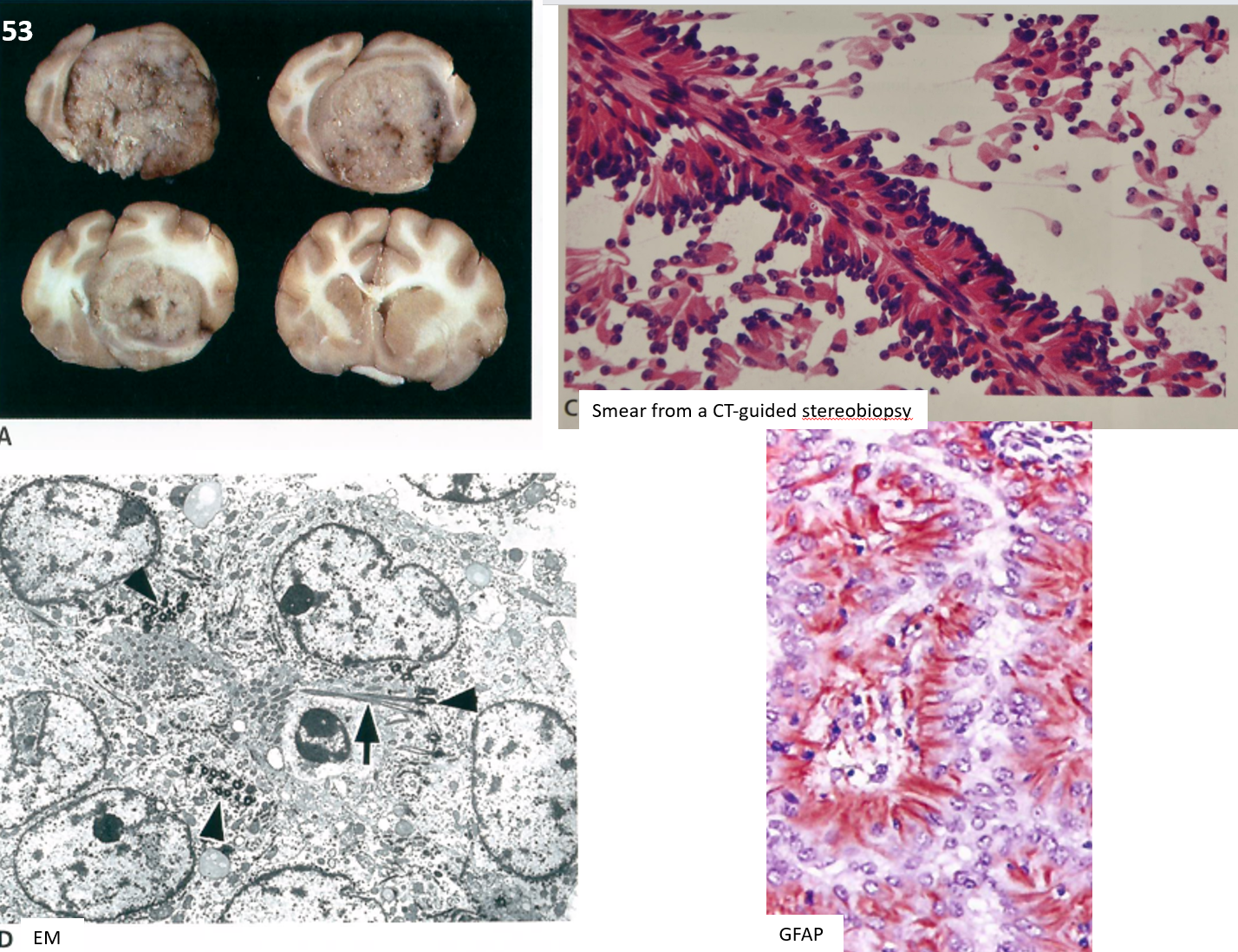
53. Tissue from a cat. What is the morphologic diagnosis?
a. Choroid plexus tumor
b. Meningioma
c. Ependymoma
d. Astrocytoma
e. Metastatic carcinoma
53. Tissue from a cat. What is the morphologic diagnosis?
a. Choroid plexus tumor
b. Meningioma
c. Ependymoma
d. Astrocytoma
e. Metastatic carcinoma
54. Which of the following mouse strains is predisposed to hypocallosity?
a. C57BL
b. BALB/c SJL
c. C3H/He
d. FVB
54. Which of the following mouse strains is predisposed to hypocallosity?
a. C57BL
b. BALB/c SJL (and 129)
c. C3H/He
d. FVB
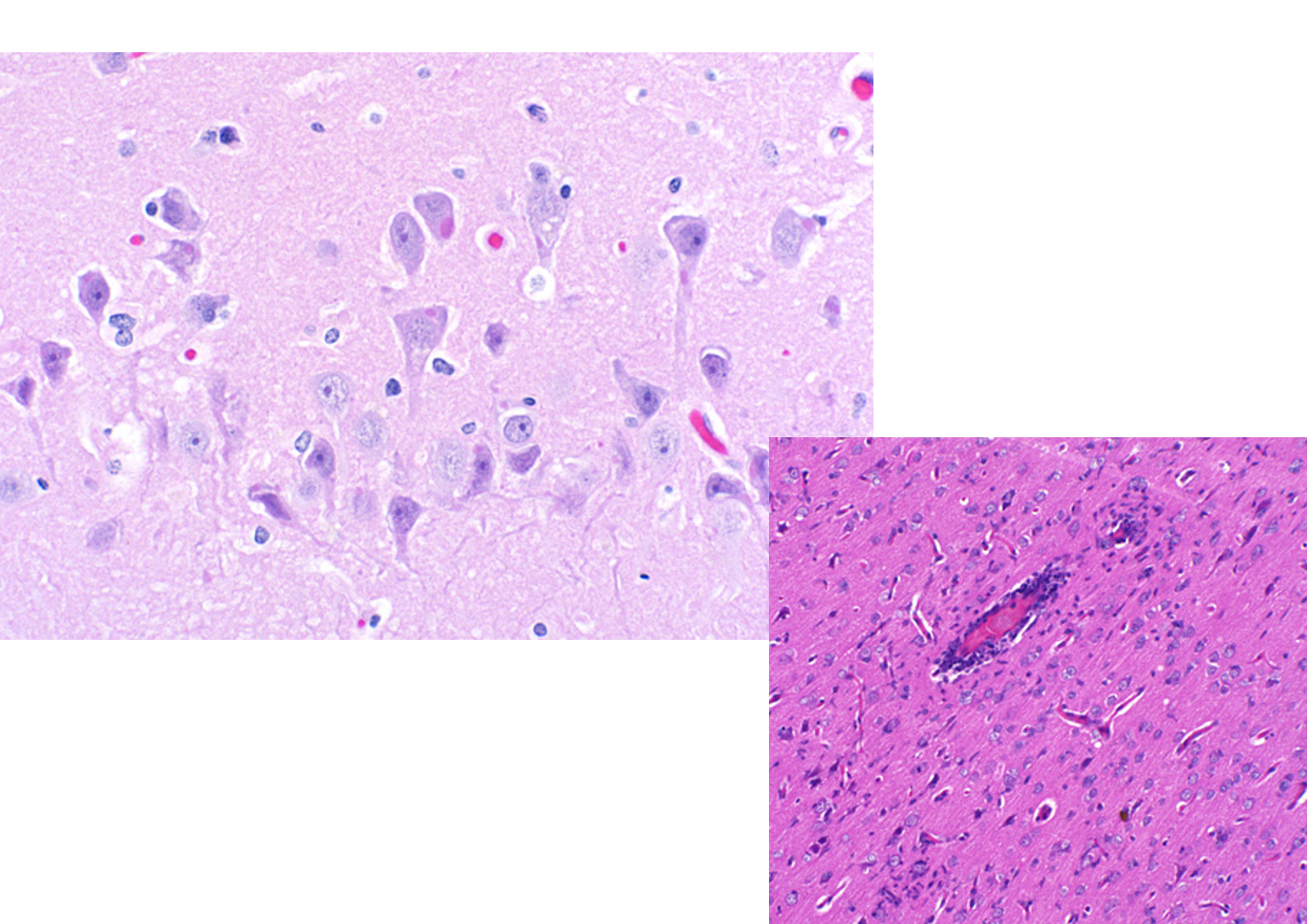
Tissue from a mink. Which is true regarding the pathogenesis of this disease?
a. Induces neuronal apoptosis by the expression of viral protease NS3
b. Envelope glycoprotein E (gE) is involved in anterograde viral spread via the olfactory pathway
c. Invades neuromuscular junction via conjugation of RVG with the nicotinic acetylcholine receptor
d. Invades neurons via entry receptor PVRL4
Tissue from a mink. Which is true regarding the pathogenesis of this disease?
a. Induces neuronal apoptosis by the expression of viral protease NS3
b. Envelope glycoprotein E (gE) is involved in anterograde viral spread via the olfactory pathway
c. Invades neuromuscular junction via conjugation of RVG with the nicotinic acetylcholine receptor (rabies; these are negri bodies and nonsuppurative perivascular cuffing)
d. Invades neurons via entry receptor PVRL4
56. Which of the following is a common neuropathologic change associated with Cytauxzoon felis infection in domestic cats?
a. Superficial laminar cerebrocortical necrosis
b. Eosinophilic meningoencephalitis
c. Bilaterally symmetrical vacuolation of the periventricular gray matter in the caudal colliculi
d. Histiocytic vascular occlusion with occasional cerebral infarcts
56. Which of the following is a common neuropathologic change associated with Cytauxzoon felis infection in domestic cats?
a. Superficial laminar cerebrocortical necrosis
b. Eosinophilic meningoencephalitis
c. Bilaterally symmetrical vacuolation of the periventricular gray matter in the caudal colliculi
d. Histiocytic vascular occlusion with occasional cerebral infarcts
57. What is the mechanism of action associated with perennial ryegrass staggers?
a. Lolitrem inhibits GABA receptors of the internuncial neurons
b. Corynetoxin inhibits dopamine release leading to glutathione depletion and oxidative damage
c. Lolitrem inhibits ceramide synthase & sphingolipid biosynthesis
d. Corynetoxin interacts w/ dopaminergic, adrenergic, and serotonergic receptors to cause arteriolar vasocontriction
57. What is the mechanism of action associated with perennial ryegrass staggers?
a. Lolitrem inhibits GABA receptors of the internuncial neurons
b. Corynetoxin inhibits dopamine release leading to glutathione depletion and oxidative damage
c. Lolitrem inhibits ceramide synthase & sphingolipid biosynthesis
d. Corynetoxin interacts w/ dopaminergic, adrenergic, and serotonergic receptors to cause arteriolar vasocontriction
58. What is the likely cause in a piglet with cerebellar hypoplasia/dysplasia, hypomyelinogenesis, microencephaly and pulmonary hypoplasia?
a. Classical swine fever virus
b. African swine fever virus
c. Teschen disease virus
d. Salt toxicity
58. What is the likely cause in a piglet with cerebellar hypoplasia/dysplasia, hypomyelinogenesis, microencephaly and pulmonary hypoplasia?
a. Classical swine fever virus
b. African swine fever virus
c. Teschen disease virus (neuronal necrosis; nonsuppurative polioencephalomalacia most severe in the brainstem; nonsuppurative myelitis confined to ventral horn grey matter)
d. Salt toxicity
Which is the most likely cause in an ox with severe necrotizing non-suppurative meningoencephalitis with marked perivascular cuffing in the gray matter of the rostral cerebrum?
a. BoHV-5
b. Theileria taurotragi
c. Thiamine deficiency
d. Bovine pestivirus
Which is the most likely cause in an ox with severe necrotizing non-suppurative meningoencephalitis with marked perivascular cuffing in the gray matter of the rostral cerebrum?
a. BoHV-5; Recent evidence suggests that BHV-5 uses an intranasal route to infect and replicate in the nasal mucosa and then enters the CNS by retrograde axonal transport predominantly through olfactory nerves.
b. Theileria taurotragi
c. Thiamine deficiency
d. Bovine pestivirus

60. Tissue from a dog. In a recent study, which of the following was NOT significantly correlated with histologic grade for this neoplasm?
a. Mitotic index
b. Intraventricular spread
c. Cell density
d. Multilayering of papillae
60. Tissue from a dog. In a recent study, which of the following was NOT significantly correlated with histologic grade for this neoplasm?
a. Mitotic index
b. Intraventricular spread
c. Cell density
d. Multilayering of papillae
Mitotic index was found to be the main criterion for grading CPTs. Cell density and multilayering of papillae were also statistically associated with histologic grade. Intraventricular spread and parenchymal invasion was observed for tumors showing histologic benign features.